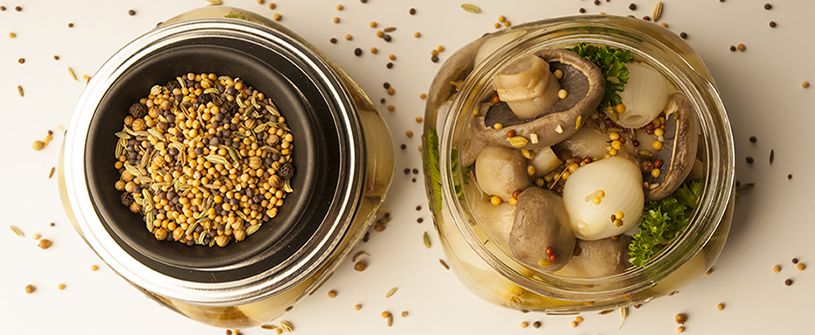The Method
Quick pickling is a fast, easy way to pickle your favorite produce without dedicating yourself to the traditional canning process. No water bath or strict sterilization standards are necessary, because quick pickles are stored in the refrigerator not in the pantry like conventionally pickled foods.
Quick pickling, or refrigerator pickling, involves a simple boil-and-pour method of pickling. You take all of your ingredients, apart from the product that is being pickled, and bring them to a boil. The heating process helps activate the flavors in the brine and marry them together. This hot brine is then poured over what is to be pickled and then stored in the refrigerator. Typically after 24 hours you’ll have a delicious pickled product that can be enjoyed over the next few weeks. (If you’re like me, though, your quick pickles won’t even last that long!)
The Ingredients
Quick pickling provides the perfect solution for those looking to pickle but don’t want to follow strict directions, as quick pickling is very customizable. There are five types of ingredients that go into almost every quick pickling recipe. These include salt, seasoning (spices/herbs), sweetener (optional), liquid (vinegar and water), and the product to be pickled. From there, the combinations are nearly endless.
Salt
In the traditional canning process, salt is used both as a preservative and a flavor component. The brine draws moisture and sugars out, promoting lactic acid production and preventing spoilage. Considering we won't be placing quick pickles in long-term storage, the salt here is purely for flavor purposes. The best type to use is pure, granulated salt. Flavored or mineral-heavy salts can lead to a cloudy brine or discoloration. But this won't impact the flavor of the pickled product, just its appearance. Our go-to salt for pickling is kosher salt. Or you can use a basic sea salt like Mayan or Pink Himalayan.
Seasoning
It's best to use the freshest spices and herbs possible when pickling. This will help provide the truest flavor and color for your quick pickles. We like using whole or cracked spices; ground spices add flavor but can sometimes yield a muddy appearance that's not too appetizing. Whenever possible, toast your spices before adding them to your brine for an extra earthy, nutty flavor. Simply add your spices to a skillet and toast over medium heat for 1 to 3 minutes, or until fragrant, then transfer immediately to your pickling bring.
If you like to explore flavors, it’s easy to create your own pickling spice blend. Some of our favorite seasonings to use for pickling include mustard seeds, peppercorns, minced garlic, minced onion, coriander seeds, and bay leaves.
Sweetener (optional)
For a mellower flavor with a little less “bite”, you can add sweetener to your pickling brine. White sugar is the preferred sweetener, as it doesn’t mask any of the other pickling flavors. Honey, agave, or flavored simple syrup can also be added to the brine. If a darker sweetener is used, like maple sugar, brown sugar, or molasses, this may affect the color of what is being pickled but will add unique flavor.
Liquid
Vinegar: The two most common types of vinegars used in pickling are apple cider vinegar and white distilled vinegar. Apple cider vinegar provides a mellow, sweet taste and can potentially darken the pickled product; whereas distilled vinegar has a sharper taste and will not lead to discoloration. White distilled vinegar is most often used as it allows the flavors of the spices and the pickled product to shine. Red wine vinegar, white wine vinegar, and rice vinegar can also be used when pickling. The flavor of your quick pickles will vary based on how acidic your vinegar is. The more acidic the vinegar, the greater “bite” your pickles will have and the sourer they will taste.
Water: Water can make up about one quarter to three quarters of the brine liquid; the more water you use, the more you dilute the bite from the vinegar. It’s best to use filtered water or soft water, as hard water can cause your pickles to become cloudy. You can substitute all or part of the water with different liquids like beer, wine, or ginger ale - just to name a few. This will add additional flavor and allow you to further experiment with your quick pickle creation.
Products you can pickle
When you hear the term “pickle” nowadays, the first thing that comes to mind is the pickled cucumber. However, there are a number of fruits, vegetables, and even meats that can be quick pickled. Among them: jalapeños, onions, beets, green tomatoes, cauliflower, Brussels sprouts, green beans, eggplant, plums, peaches, watermelon rind, mango, pineapple, blueberries, eggs, pork, fish, and even bologna!
Get Pickling!
Here are two easy quick pickling brine recipes to get you started:
Sweet Quick Pickle Brine
3 cups water
3 cups apple cider vinegar
1 cup white sugar
1 Tbsp. kosher salt
Sharp Quick Pickle Brine
4 cups water
2 cups white distilled vinegar
3 Tbsp. kosher salt
For either brine, have these items ready to go:
4 clean pint jars with lids
1 to 2 lb. of your favorite veggie or fruit, cleaned and cut into bite size pieces
2 Tbsp. of your favorite pickling spice blend, toasted if desired
Directions: Pack veggies into the pint jars. Choose which brine you want to make and bring the brine ingredients and pickling spice blend to a boil. Simmer for 2 to 3 minutes. Pour seasoned brine into jars to cover veggies. Let them cool to room temperature then seal and refrigerate. Your quick pickles will be ready to serve after 24 hours in the refrigerator. Keep refrigerated and enjoy within a few weeks.
You can also check out one these easy recipes to get started on your pickling adventure:
